An Investigation into Media Audiences, Ideology, and Capitalism
VerifiedAdded on 2022/11/24
|6
|1788
|332
Essay
AI Summary
This essay delves into the intricate relationship between media audiences and dominant ideologies, with a particular focus on the pervasive influence of capitalism. It argues that the media serves as a powerful vehicle for disseminating and reinforcing dominant ideologies, thereby shaping audience perceptions and behaviors. The analysis examines how media representations, such as those found in advertisements like Nike's and in digital games like Pokemon, reflect and promote capitalist values, including competition and consumerism. The essay highlights the concept of the 'hypodermic needle model' to explain how media messages can be readily accepted, often without critical evaluation. By exploring these dynamics, the essay underscores the significant role of media in constructing and perpetuating dominant ideologies within society, ultimately influencing how individuals understand and interact with the world around them. The conclusion emphasizes the need for critical engagement with media content to recognize the underlying ideological frameworks at play.
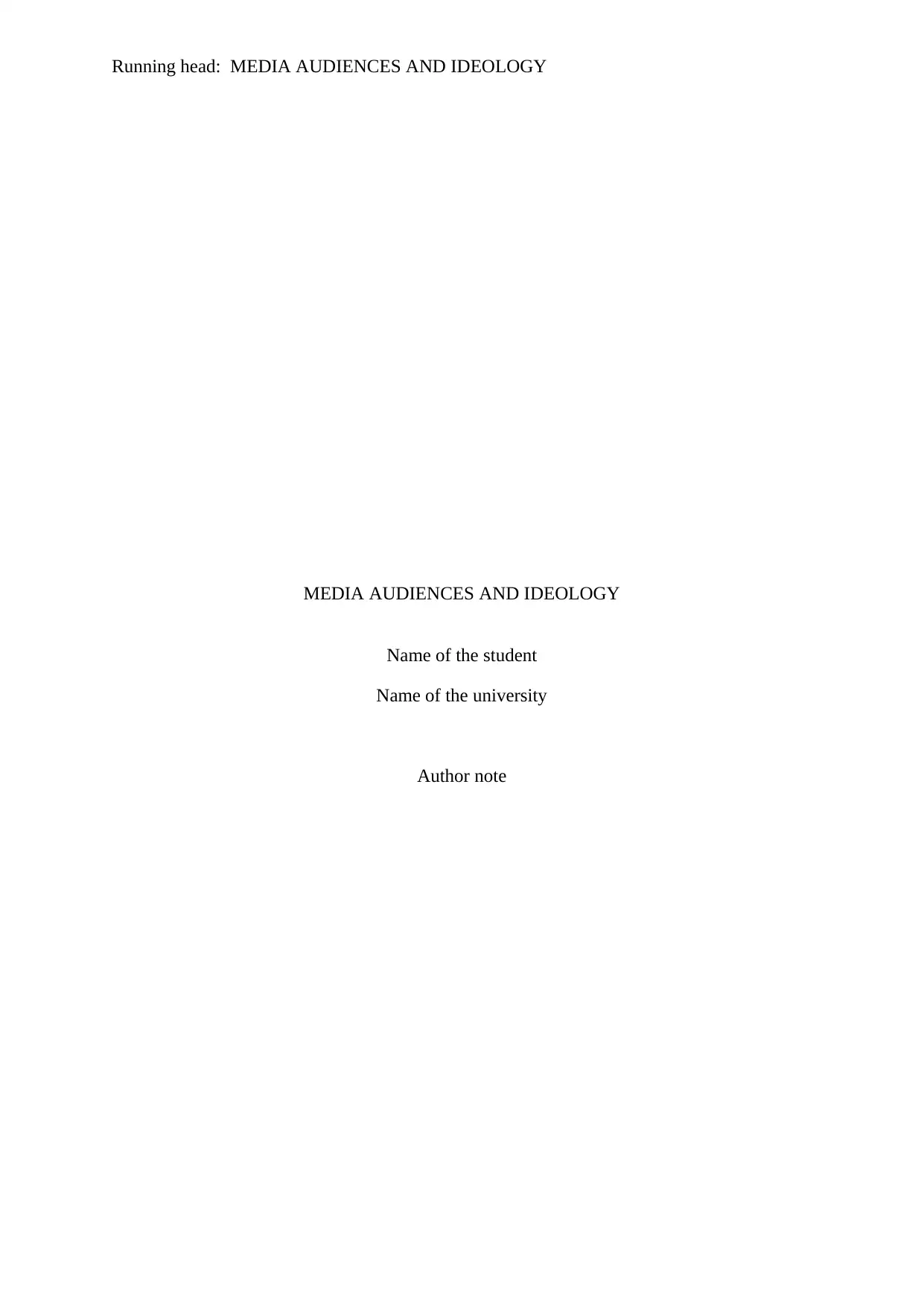
Running head: MEDIA AUDIENCES AND IDEOLOGY
MEDIA AUDIENCES AND IDEOLOGY
Name of the student
Name of the university
Author note
MEDIA AUDIENCES AND IDEOLOGY
Name of the student
Name of the university
Author note
Paraphrase This Document
Need a fresh take? Get an instant paraphrase of this document with our AI Paraphraser
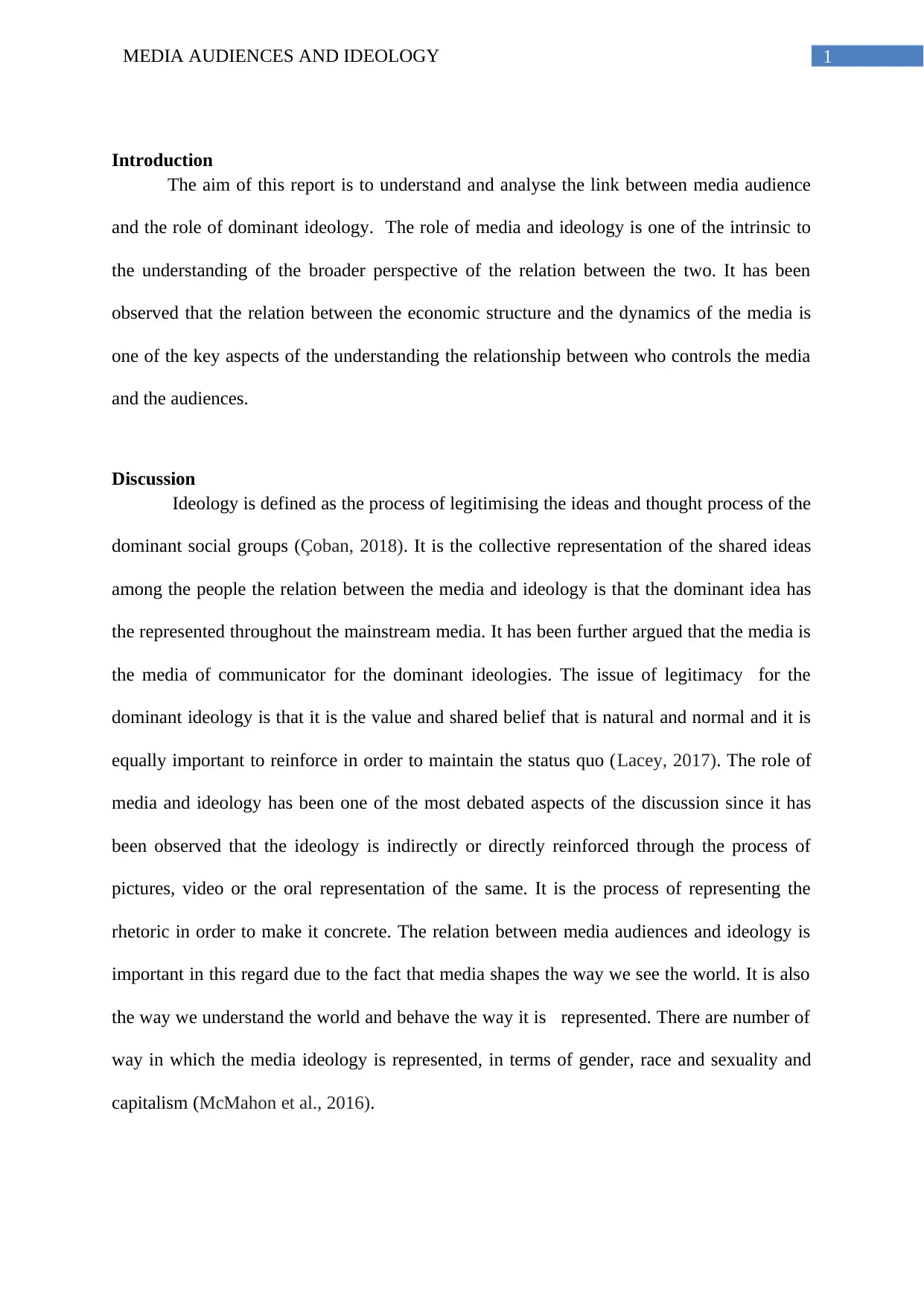
1MEDIA AUDIENCES AND IDEOLOGY
Introduction
The aim of this report is to understand and analyse the link between media audience
and the role of dominant ideology. The role of media and ideology is one of the intrinsic to
the understanding of the broader perspective of the relation between the two. It has been
observed that the relation between the economic structure and the dynamics of the media is
one of the key aspects of the understanding the relationship between who controls the media
and the audiences.
Discussion
Ideology is defined as the process of legitimising the ideas and thought process of the
dominant social groups (Çoban, 2018). It is the collective representation of the shared ideas
among the people the relation between the media and ideology is that the dominant idea has
the represented throughout the mainstream media. It has been further argued that the media is
the media of communicator for the dominant ideologies. The issue of legitimacy for the
dominant ideology is that it is the value and shared belief that is natural and normal and it is
equally important to reinforce in order to maintain the status quo (Lacey, 2017). The role of
media and ideology has been one of the most debated aspects of the discussion since it has
been observed that the ideology is indirectly or directly reinforced through the process of
pictures, video or the oral representation of the same. It is the process of representing the
rhetoric in order to make it concrete. The relation between media audiences and ideology is
important in this regard due to the fact that media shapes the way we see the world. It is also
the way we understand the world and behave the way it is represented. There are number of
way in which the media ideology is represented, in terms of gender, race and sexuality and
capitalism (McMahon et al., 2016).
Introduction
The aim of this report is to understand and analyse the link between media audience
and the role of dominant ideology. The role of media and ideology is one of the intrinsic to
the understanding of the broader perspective of the relation between the two. It has been
observed that the relation between the economic structure and the dynamics of the media is
one of the key aspects of the understanding the relationship between who controls the media
and the audiences.
Discussion
Ideology is defined as the process of legitimising the ideas and thought process of the
dominant social groups (Çoban, 2018). It is the collective representation of the shared ideas
among the people the relation between the media and ideology is that the dominant idea has
the represented throughout the mainstream media. It has been further argued that the media is
the media of communicator for the dominant ideologies. The issue of legitimacy for the
dominant ideology is that it is the value and shared belief that is natural and normal and it is
equally important to reinforce in order to maintain the status quo (Lacey, 2017). The role of
media and ideology has been one of the most debated aspects of the discussion since it has
been observed that the ideology is indirectly or directly reinforced through the process of
pictures, video or the oral representation of the same. It is the process of representing the
rhetoric in order to make it concrete. The relation between media audiences and ideology is
important in this regard due to the fact that media shapes the way we see the world. It is also
the way we understand the world and behave the way it is represented. There are number of
way in which the media ideology is represented, in terms of gender, race and sexuality and
capitalism (McMahon et al., 2016).
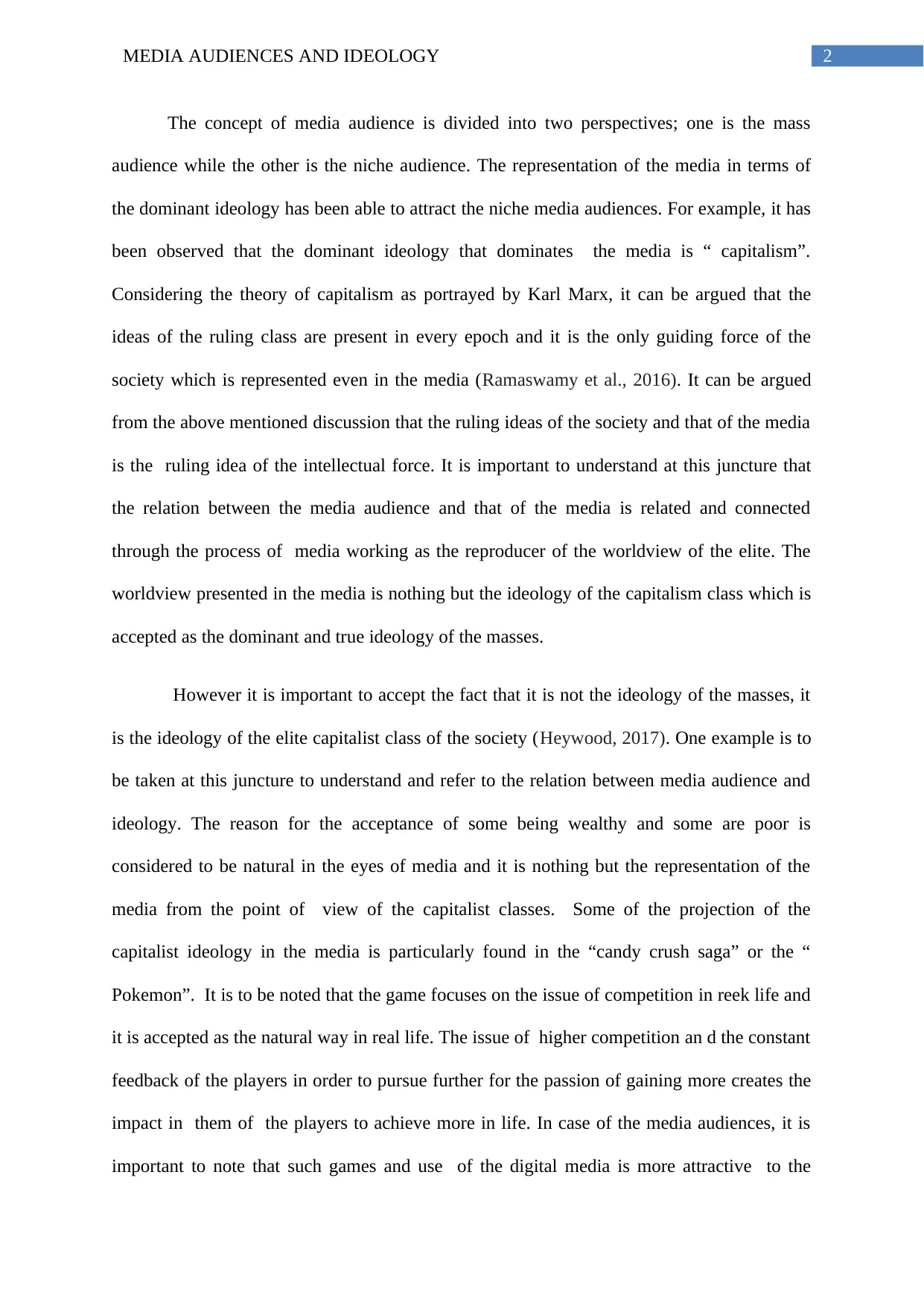
2MEDIA AUDIENCES AND IDEOLOGY
The concept of media audience is divided into two perspectives; one is the mass
audience while the other is the niche audience. The representation of the media in terms of
the dominant ideology has been able to attract the niche media audiences. For example, it has
been observed that the dominant ideology that dominates the media is “ capitalism”.
Considering the theory of capitalism as portrayed by Karl Marx, it can be argued that the
ideas of the ruling class are present in every epoch and it is the only guiding force of the
society which is represented even in the media (Ramaswamy et al., 2016). It can be argued
from the above mentioned discussion that the ruling ideas of the society and that of the media
is the ruling idea of the intellectual force. It is important to understand at this juncture that
the relation between the media audience and that of the media is related and connected
through the process of media working as the reproducer of the worldview of the elite. The
worldview presented in the media is nothing but the ideology of the capitalism class which is
accepted as the dominant and true ideology of the masses.
However it is important to accept the fact that it is not the ideology of the masses, it
is the ideology of the elite capitalist class of the society (Heywood, 2017). One example is to
be taken at this juncture to understand and refer to the relation between media audience and
ideology. The reason for the acceptance of some being wealthy and some are poor is
considered to be natural in the eyes of media and it is nothing but the representation of the
media from the point of view of the capitalist classes. Some of the projection of the
capitalist ideology in the media is particularly found in the “candy crush saga” or the “
Pokemon”. It is to be noted that the game focuses on the issue of competition in reek life and
it is accepted as the natural way in real life. The issue of higher competition an d the constant
feedback of the players in order to pursue further for the passion of gaining more creates the
impact in them of the players to achieve more in life. In case of the media audiences, it is
important to note that such games and use of the digital media is more attractive to the
The concept of media audience is divided into two perspectives; one is the mass
audience while the other is the niche audience. The representation of the media in terms of
the dominant ideology has been able to attract the niche media audiences. For example, it has
been observed that the dominant ideology that dominates the media is “ capitalism”.
Considering the theory of capitalism as portrayed by Karl Marx, it can be argued that the
ideas of the ruling class are present in every epoch and it is the only guiding force of the
society which is represented even in the media (Ramaswamy et al., 2016). It can be argued
from the above mentioned discussion that the ruling ideas of the society and that of the media
is the ruling idea of the intellectual force. It is important to understand at this juncture that
the relation between the media audience and that of the media is related and connected
through the process of media working as the reproducer of the worldview of the elite. The
worldview presented in the media is nothing but the ideology of the capitalism class which is
accepted as the dominant and true ideology of the masses.
However it is important to accept the fact that it is not the ideology of the masses, it
is the ideology of the elite capitalist class of the society (Heywood, 2017). One example is to
be taken at this juncture to understand and refer to the relation between media audience and
ideology. The reason for the acceptance of some being wealthy and some are poor is
considered to be natural in the eyes of media and it is nothing but the representation of the
media from the point of view of the capitalist classes. Some of the projection of the
capitalist ideology in the media is particularly found in the “candy crush saga” or the “
Pokemon”. It is to be noted that the game focuses on the issue of competition in reek life and
it is accepted as the natural way in real life. The issue of higher competition an d the constant
feedback of the players in order to pursue further for the passion of gaining more creates the
impact in them of the players to achieve more in life. In case of the media audiences, it is
important to note that such games and use of the digital media is more attractive to the
⊘ This is a preview!⊘
Do you want full access?
Subscribe today to unlock all pages.

Trusted by 1+ million students worldwide
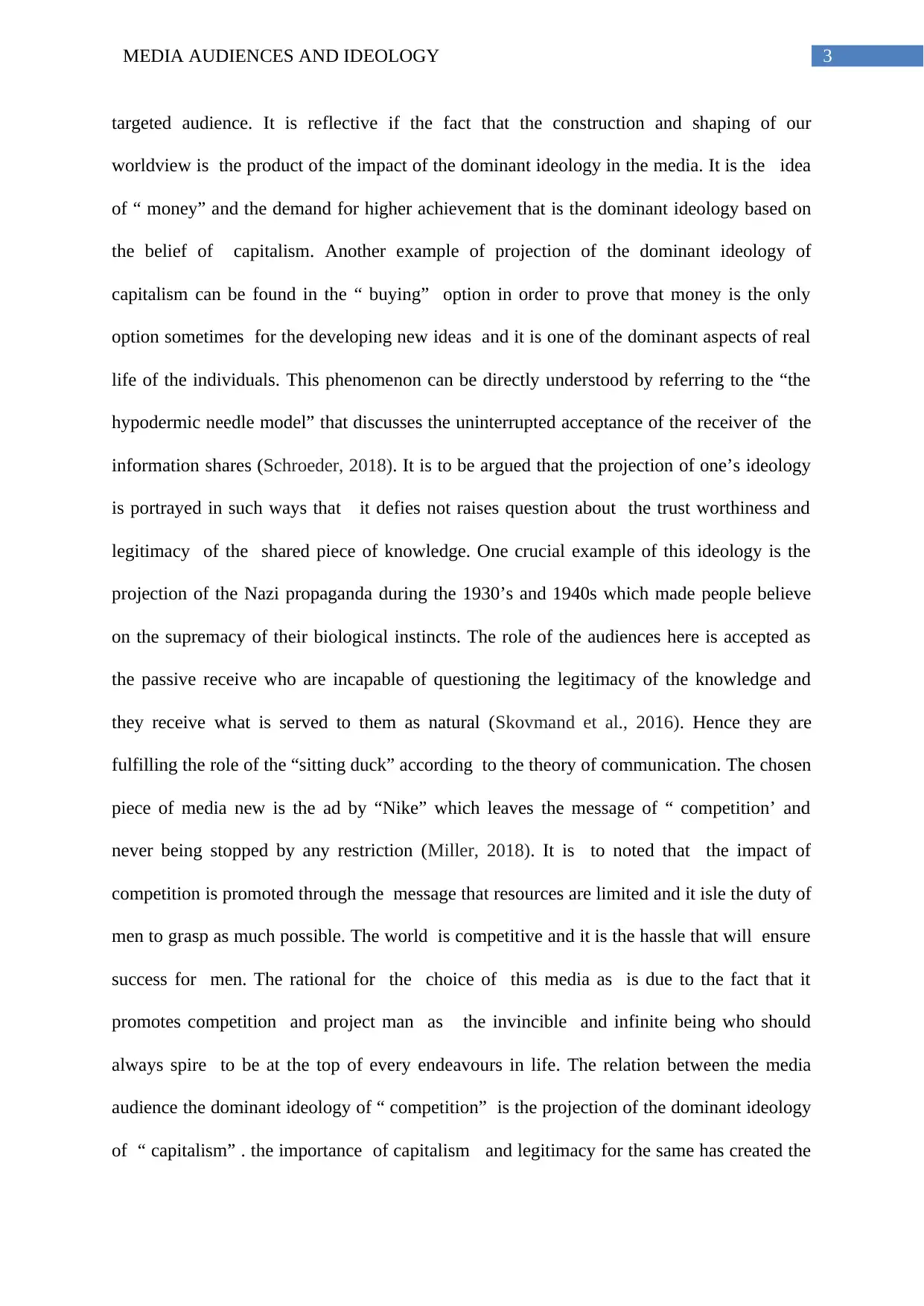
3MEDIA AUDIENCES AND IDEOLOGY
targeted audience. It is reflective if the fact that the construction and shaping of our
worldview is the product of the impact of the dominant ideology in the media. It is the idea
of “ money” and the demand for higher achievement that is the dominant ideology based on
the belief of capitalism. Another example of projection of the dominant ideology of
capitalism can be found in the “ buying” option in order to prove that money is the only
option sometimes for the developing new ideas and it is one of the dominant aspects of real
life of the individuals. This phenomenon can be directly understood by referring to the “the
hypodermic needle model” that discusses the uninterrupted acceptance of the receiver of the
information shares (Schroeder, 2018). It is to be argued that the projection of one’s ideology
is portrayed in such ways that it defies not raises question about the trust worthiness and
legitimacy of the shared piece of knowledge. One crucial example of this ideology is the
projection of the Nazi propaganda during the 1930’s and 1940s which made people believe
on the supremacy of their biological instincts. The role of the audiences here is accepted as
the passive receive who are incapable of questioning the legitimacy of the knowledge and
they receive what is served to them as natural (Skovmand et al., 2016). Hence they are
fulfilling the role of the “sitting duck” according to the theory of communication. The chosen
piece of media new is the ad by “Nike” which leaves the message of “ competition’ and
never being stopped by any restriction (Miller, 2018). It is to noted that the impact of
competition is promoted through the message that resources are limited and it isle the duty of
men to grasp as much possible. The world is competitive and it is the hassle that will ensure
success for men. The rational for the choice of this media as is due to the fact that it
promotes competition and project man as the invincible and infinite being who should
always spire to be at the top of every endeavours in life. The relation between the media
audience the dominant ideology of “ competition” is the projection of the dominant ideology
of “ capitalism” . the importance of capitalism and legitimacy for the same has created the
targeted audience. It is reflective if the fact that the construction and shaping of our
worldview is the product of the impact of the dominant ideology in the media. It is the idea
of “ money” and the demand for higher achievement that is the dominant ideology based on
the belief of capitalism. Another example of projection of the dominant ideology of
capitalism can be found in the “ buying” option in order to prove that money is the only
option sometimes for the developing new ideas and it is one of the dominant aspects of real
life of the individuals. This phenomenon can be directly understood by referring to the “the
hypodermic needle model” that discusses the uninterrupted acceptance of the receiver of the
information shares (Schroeder, 2018). It is to be argued that the projection of one’s ideology
is portrayed in such ways that it defies not raises question about the trust worthiness and
legitimacy of the shared piece of knowledge. One crucial example of this ideology is the
projection of the Nazi propaganda during the 1930’s and 1940s which made people believe
on the supremacy of their biological instincts. The role of the audiences here is accepted as
the passive receive who are incapable of questioning the legitimacy of the knowledge and
they receive what is served to them as natural (Skovmand et al., 2016). Hence they are
fulfilling the role of the “sitting duck” according to the theory of communication. The chosen
piece of media new is the ad by “Nike” which leaves the message of “ competition’ and
never being stopped by any restriction (Miller, 2018). It is to noted that the impact of
competition is promoted through the message that resources are limited and it isle the duty of
men to grasp as much possible. The world is competitive and it is the hassle that will ensure
success for men. The rational for the choice of this media as is due to the fact that it
promotes competition and project man as the invincible and infinite being who should
always spire to be at the top of every endeavours in life. The relation between the media
audience the dominant ideology of “ competition” is the projection of the dominant ideology
of “ capitalism” . the importance of capitalism and legitimacy for the same has created the
Paraphrase This Document
Need a fresh take? Get an instant paraphrase of this document with our AI Paraphraser
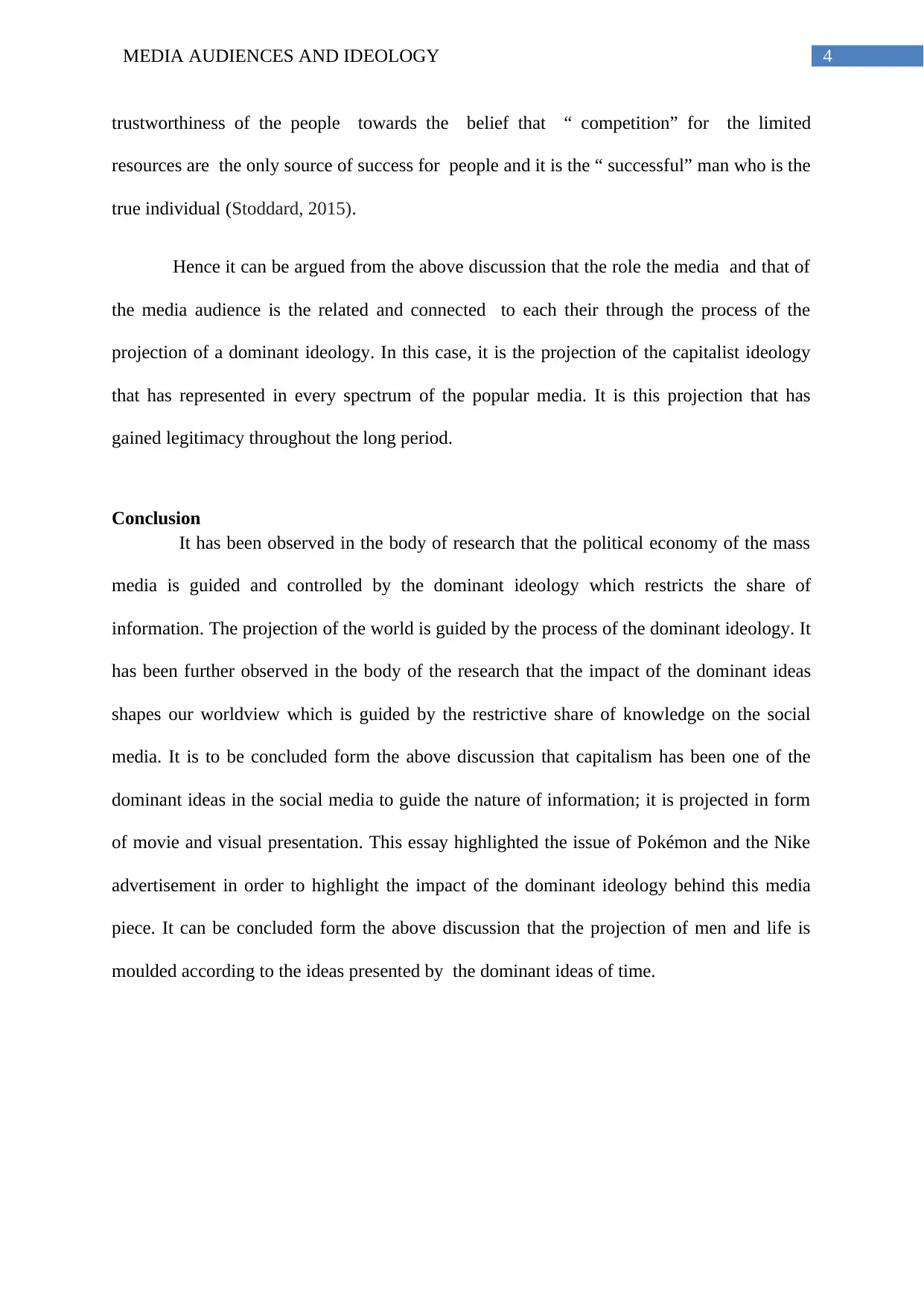
4MEDIA AUDIENCES AND IDEOLOGY
trustworthiness of the people towards the belief that “ competition” for the limited
resources are the only source of success for people and it is the “ successful” man who is the
true individual (Stoddard, 2015).
Hence it can be argued from the above discussion that the role the media and that of
the media audience is the related and connected to each their through the process of the
projection of a dominant ideology. In this case, it is the projection of the capitalist ideology
that has represented in every spectrum of the popular media. It is this projection that has
gained legitimacy throughout the long period.
Conclusion
It has been observed in the body of research that the political economy of the mass
media is guided and controlled by the dominant ideology which restricts the share of
information. The projection of the world is guided by the process of the dominant ideology. It
has been further observed in the body of the research that the impact of the dominant ideas
shapes our worldview which is guided by the restrictive share of knowledge on the social
media. It is to be concluded form the above discussion that capitalism has been one of the
dominant ideas in the social media to guide the nature of information; it is projected in form
of movie and visual presentation. This essay highlighted the issue of Pokémon and the Nike
advertisement in order to highlight the impact of the dominant ideology behind this media
piece. It can be concluded form the above discussion that the projection of men and life is
moulded according to the ideas presented by the dominant ideas of time.
trustworthiness of the people towards the belief that “ competition” for the limited
resources are the only source of success for people and it is the “ successful” man who is the
true individual (Stoddard, 2015).
Hence it can be argued from the above discussion that the role the media and that of
the media audience is the related and connected to each their through the process of the
projection of a dominant ideology. In this case, it is the projection of the capitalist ideology
that has represented in every spectrum of the popular media. It is this projection that has
gained legitimacy throughout the long period.
Conclusion
It has been observed in the body of research that the political economy of the mass
media is guided and controlled by the dominant ideology which restricts the share of
information. The projection of the world is guided by the process of the dominant ideology. It
has been further observed in the body of the research that the impact of the dominant ideas
shapes our worldview which is guided by the restrictive share of knowledge on the social
media. It is to be concluded form the above discussion that capitalism has been one of the
dominant ideas in the social media to guide the nature of information; it is projected in form
of movie and visual presentation. This essay highlighted the issue of Pokémon and the Nike
advertisement in order to highlight the impact of the dominant ideology behind this media
piece. It can be concluded form the above discussion that the projection of men and life is
moulded according to the ideas presented by the dominant ideas of time.
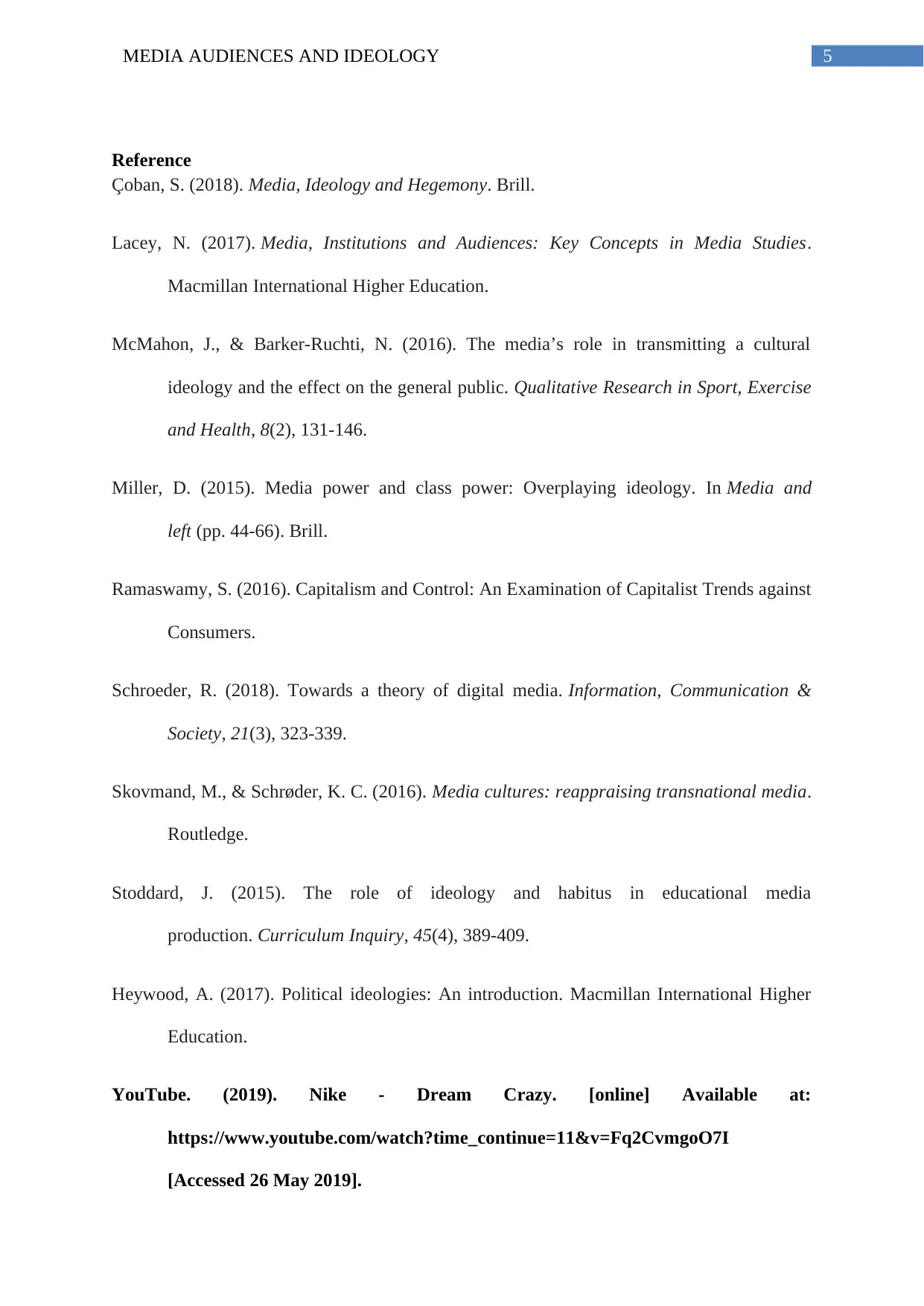
5MEDIA AUDIENCES AND IDEOLOGY
Reference
Çoban, S. (2018). Media, Ideology and Hegemony. Brill.
Lacey, N. (2017). Media, Institutions and Audiences: Key Concepts in Media Studies.
Macmillan International Higher Education.
McMahon, J., & Barker-Ruchti, N. (2016). The media’s role in transmitting a cultural
ideology and the effect on the general public. Qualitative Research in Sport, Exercise
and Health, 8(2), 131-146.
Miller, D. (2015). Media power and class power: Overplaying ideology. In Media and
left (pp. 44-66). Brill.
Ramaswamy, S. (2016). Capitalism and Control: An Examination of Capitalist Trends against
Consumers.
Schroeder, R. (2018). Towards a theory of digital media. Information, Communication &
Society, 21(3), 323-339.
Skovmand, M., & Schrøder, K. C. (2016). Media cultures: reappraising transnational media.
Routledge.
Stoddard, J. (2015). The role of ideology and habitus in educational media
production. Curriculum Inquiry, 45(4), 389-409.
Heywood, A. (2017). Political ideologies: An introduction. Macmillan International Higher
Education.
YouTube. (2019). Nike - Dream Crazy. [online] Available at:
https://www.youtube.com/watch?time_continue=11&v=Fq2CvmgoO7I
[Accessed 26 May 2019].
Reference
Çoban, S. (2018). Media, Ideology and Hegemony. Brill.
Lacey, N. (2017). Media, Institutions and Audiences: Key Concepts in Media Studies.
Macmillan International Higher Education.
McMahon, J., & Barker-Ruchti, N. (2016). The media’s role in transmitting a cultural
ideology and the effect on the general public. Qualitative Research in Sport, Exercise
and Health, 8(2), 131-146.
Miller, D. (2015). Media power and class power: Overplaying ideology. In Media and
left (pp. 44-66). Brill.
Ramaswamy, S. (2016). Capitalism and Control: An Examination of Capitalist Trends against
Consumers.
Schroeder, R. (2018). Towards a theory of digital media. Information, Communication &
Society, 21(3), 323-339.
Skovmand, M., & Schrøder, K. C. (2016). Media cultures: reappraising transnational media.
Routledge.
Stoddard, J. (2015). The role of ideology and habitus in educational media
production. Curriculum Inquiry, 45(4), 389-409.
Heywood, A. (2017). Political ideologies: An introduction. Macmillan International Higher
Education.
YouTube. (2019). Nike - Dream Crazy. [online] Available at:
https://www.youtube.com/watch?time_continue=11&v=Fq2CvmgoO7I
[Accessed 26 May 2019].
⊘ This is a preview!⊘
Do you want full access?
Subscribe today to unlock all pages.

Trusted by 1+ million students worldwide
1 out of 6
Related Documents
Your All-in-One AI-Powered Toolkit for Academic Success.
+13062052269
info@desklib.com
Available 24*7 on WhatsApp / Email
![[object Object]](/_next/static/media/star-bottom.7253800d.svg)
Unlock your academic potential
Copyright © 2020–2025 A2Z Services. All Rights Reserved. Developed and managed by ZUCOL.





